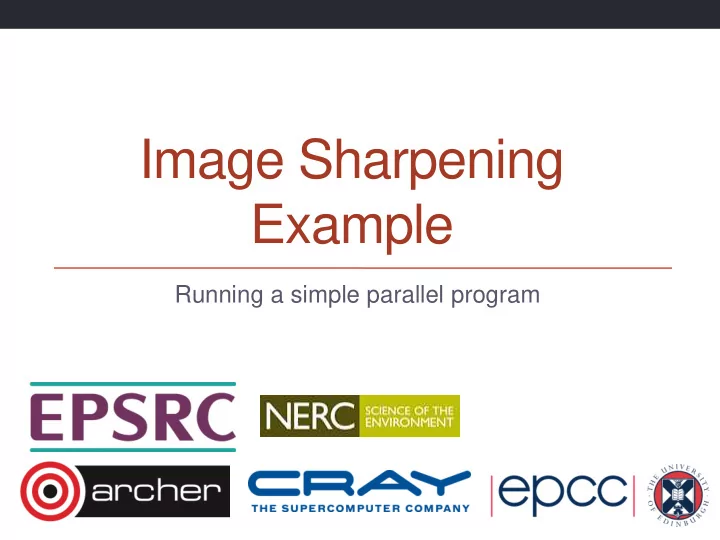

Image Sharpening Example Running a simple parallel program
Aims (i) To familiarise yourself with running parallel programs • To run a real parallel code (that does file I/O) • • on different numbers of cores • measure the time taken observe increase in performance (Amdahl’s law? – see later) • Acknowledgements • • algorithm, diagrams and images taken from: • Hypermedia Image Processing Reference , Bob Fisher, Simon Perkins, Ashley Walker and Erik Wolfart, Department of Artificial Intelligence, University of Edinburgh (1994)
Aims (ii) To get you running on ARCHER • • To sort out all the practical details • usernames • passwords • graphics transferring files • • using the batch system idiosyncrasies of your Windows / Mac / Linux laptop • … • Please ask for assistance if you need it! • • demonstrators are here to help with all aspects of course
Image sharpening • Images can be fuzzy for two main reasons random noise • • blurring • Aim to improve quality by smoothing to remove noise • • detecting edges • sharpening up the image with the edges fuzzy edges sharp
Technicalities • Each pixel replaced by a weighted average of its neighbours weighted by a 2D Gaussian • averaged over a square region • • we will use: • Gaussian width of 1.4 a 17x17 square • then apply a Laplacian • • this detects edges a 2D second-derivative 2 • Combine both operations • produces a single convolution filter •
Implementation For over every pixel in the image • loop over all pixels in the 17x17 square surrounding it • add in the value of the pixel weighted by a filter • This gives the edges • • add the edges back into the original image with some scaling factor • we use 2.0 • rescale the sharpened image so pixels lie in the range 0 - 255
Parallelisation • Each pixel can be processed independently • A master process reads the image Broadcast the whole image to every process • Each process computes edges for a subset of pixels: • • scan the image line by line • with four processes, each process computes every fourth pixel Combine the edges back onto a master process • • add back into original image and rescale • save to disk Reports two times: • • calculation time for just computing edges on each process • overall time for the whole program including IO
Parallelisation 1 2 3 4 1 2 3 4 1 2 3
Technicalities • Supply a serial version for reference • Parallelisation is achieved using message-passing model Implemented using MPI • the Message-Passing Interface • • Another version parallelised using shared-variables model • Implemented using OpenMP HPC standard for threaded programming • • for interest - not critical to this exercise These concepts will be explained later in the course … •
PBS job submission scripts name for PBS batch job #PBS -N sharpen #PBS -l select=1 how many nodes # now stuff that actually executes you want … aprun -n 4 ./sharpen program to run parallel job launcher how many cores to run on – remember 24 cores per node!
Compiling and Running • We provide a tar file with code (C or Fortran) and image You should: • • copy tar file it to your local account • unpack it • compile it • run it on the back end using appropriate batch scripts view the input and output images using display program • • note the times for different numbers of processors • can you interpret them? • See the exercise sheet for full details!
Recommend
More recommend